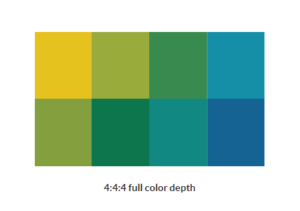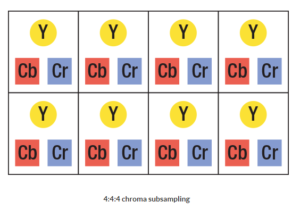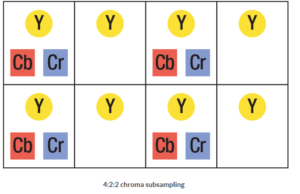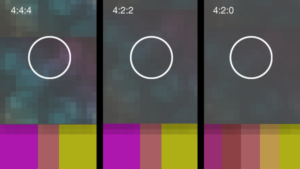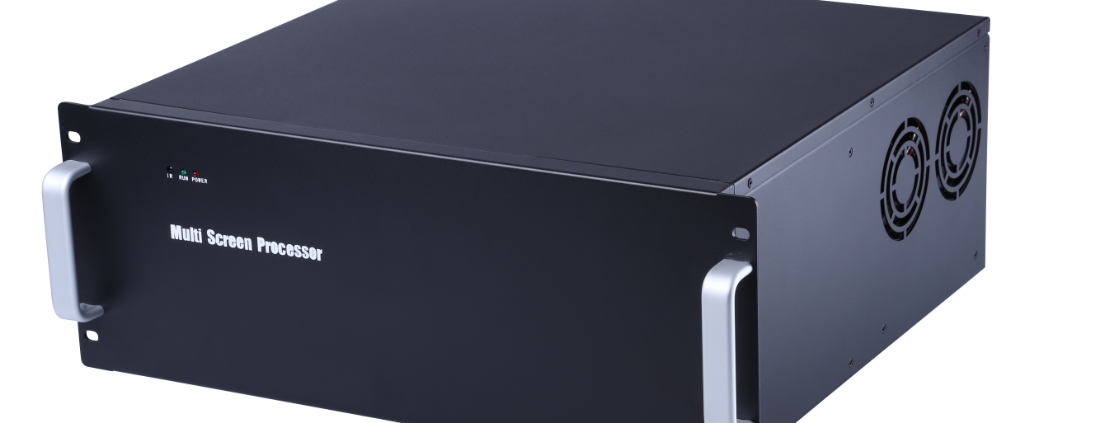Transcoding and transrating
Transcoding and transrating are other forms of encoding. This refers to taking digital video and converting it. An example of transcoding is taking a video asset from one format, such as MPEG-2, and converting it to another format, such as H.264. An example of transrating is taking a video asset and converting its resolution or bitrate characteristics but keeping the format the same; such as H.264 for example. For some operations of transcoding, video must be decoded and then re-encoded. For other types of transcoding, the same encoding format can be maintained but things such as the streaming protocols can be altered.
Sometimes software running on-premises or in the cloud as a service can be used for transcoding applications. The purpose and performance requirements of transcoding operations vary greatly. The amount of latency that can be tolerated by a streaming video workflow can impact choices for both the original encoding of various media and the transcoding options.
Encoding with or without compression
Encoding raw video can be achieved with compression and with no compression.
In video editing environments, for example, video is often manipulated, and many workflows are designed with digital uncompressed video.
In applications where video is being served to users on the internet, video is usually compressed so it can fit on networks and be viewed on many different devices.
When video is made available directly from content owners to content viewers, by-passing cable and satellite service providers for example, this is sometimes referred to as “over-the-top” content or OTT for short. Almost all content that reaches a viewer, in any format, is compressed video. This includes OTT, Blu-ray, online streaming, and even cinema.
While video can be encoded (digitized) with or without compression, when compression is involved this usually involves a video codec, which is shorthand for: compression/decompression.
When the purpose of encoding is for live streaming or on-demand streaming of recorded media, video codecs–such as H.264–are used to compress the video. Software and hardware decoders reverse the process and allow you to view the media.
Real-time vs. non real-time encoding
Encoding video is an operation that can happen in real-time or something that can happen with more considerable latency.
Much of the on-line video available in streaming services for movies and shows, for example, uses multi-pass encoding to exploit compression technologies that offer viewers the best blend of performance and quality-of-service. Image quality and bitrate are normally inversely correlated where optimizing one penalizes the other. But the bitrates of video can be significantly mitigated using multi-pass techniques, while still producing exceptional quality and performance to viewers.
In other instances, real-time video encoding better suits the application. For example, in live streaming applications, where only very nominal latency is tolerable between the camera and the viewing audience, the video is often captured, encoded, and packaged for distribution with very little delay.
On-line meetings and web conferences normally use real-time video encoding as do professionally-produced live webcasts.
Note: the “on-demand” version of web conferences and webcasts that are recorded for later consumption by viewers on their own time are usually in the same format as the original live event handled by a real-time video encoder. This is because quality cannot be added back once the video goes through its original encoding with compression.
One of the major distinguishing features between hardware-based and software-based real-time encoders for applications over bandwidth constrained networks is the latency, quality, and bitrate optimization that they can achieve. The best encoders, both hardware and software based, can produce exceptional quality at very low latency and very low bitrates.
Sometimes encoders can also be tightly-coupled with corresponding decoders. This means that vendors offer both ends with certain additional optimizations. For example, the ease and automation to connect source and destination end-points, the signal management and switching, and the overall performance and quality can be tuned to supplement and augment or, in some cases, entirely replace traditional hardwired AV infrastructures.
Hardware vs. software encoding
The difference between hardware and software encoding is that hardware encoding uses purpose-built processing for encoding, whereas software encoding relies on general-purpose processing for encoding.
When encoding is performed by dedicated hardware, the hardware is designed to carry out the encoding rules automatically. Good hardware design allows for higher quality video and low power consumption and extremely low latencies, and can be combined with other features. These are usually installed in situations where there is a need for live encoding.
Software encoding also uses hardware but uses more general-purpose processing such as CPUs in personal computers or handheld devices. In most cases software encoding exhibits much higher latency and power requirements. The impact to latency and power using software encoding is even higher for high-quality video. Many modern CPUs and GPUs incorporate some level of hardware acceleration for encoding. Some are I/O limited and mainly used for transcoding. Others incorporate a hardware encode for a single stream, for example to share a video game being played.
A good example of a use for software encoding using high-quality video is video editing, where content editors save changes often. Uncompressed encoded video is used to maintain quality. At the end of the video editing process, re-encoding (transcoding) the video, this time using compression, allows the video to be shared for viewing or stored in a reduced file size. While uncompressed video usually remains stored somewhere for future editing options, extra copies of the video, used for viewing, are often in compressed format. Moving uncompressed video is extremely heavy on bandwidth. Even with new high-bandwidth networks, effective bandwidth and scalability are always maximized when video is compressed.
Another example of software encoding can be using a personal computer’s camera or a smart handheld device to carry out video conferencing (or video calls). This is often an application of highly compressed video encoding carried out in software running on CPUs.
To users, the distinction between hardware-accelerated encoding versus software encoding can be nebulous. Hardware acceleration serves multiple different purposes for different workflows. For example: many handheld devices contain CPUs that can accelerate the encoding of highly compressed video for applications such as video calls. The “goal” of hardware acceleration in this case is to protect the battery life of the handheld device from a software process running on the CPU of said device without acceleration. Left to run entirely in software, video calls, watching streaming video on YouTube, or watching videos stored on the phone, would all be activities that would significantly drain the battery life.
There is a correlation between the “complexity” of the encoding task with respect to whether software encoding—running on general-purpose computing—is used, or whether hardware-accelerated encoding is used. Maintaining video quality while significantly compressing the size of the video for storage or transmission on networks is an example of complexity.
This is one of the reasons why video standards are very important. The fact that H.264 has been a long-serving video standard has meant that it is hardware-accelerated in smart handheld devices and personal computers. This has been one of the major reasons it has been so easy to produce, share, and consume video content.
Streaming video services offering home users with movies and shows sometimes use software-based encoding to achieve the highest quality at the lowest bitrates for reliable high-quality experiences to millions of concurrent users. But for such a targeted use-case, they use a large number of computers for very long runtimes to find the most optimal encoding parameters. This is not done in real-time and is more suitable for on-demand streaming, versus live streaming.
For encoding applications with more narrowcast applications, such as video editing infrastructures, it makes sense to use less complex processing for uncompressed or lightly-compressed encoding.
For corporate, government, education, and other organizations that produce a lot of video for their own consumption (versus video that is produced for sale to consumers), there is a need to balance many variables. Video quality is important. Maintaining quality while fitting on networks for reliability and performance is critical. Keeping encoding latency low, video quality high, and bandwidth low is essential for live streaming applications. “Recording” for on-demand streaming is often performed in the same step as encoding for live streaming. So the high-bandwidth approach of video editing infrastructures is not practical here. And the highly-optimized multi-pass encoding approach from movie streaming services is both out-of-budget as well as non-real-time and does not fit many applications from these organizations.
Encoding for streaming and recording
Encoding the video is only the first step in the process for streaming or recording. So how does the encoded video get from the encoder to the viewer, or to the recording device? The encoder needs to send the video somewhere, but it also needs to tell the receiver what it is sending.
Streaming protocols are different video streaming delivery rules and optimizations that are encapsulated to deal with different objectives and priorities such as video latency, network bandwidth, broad device compatibility, video frame rate and performance, and more.
Streaming protocols allow video that has been encoded to subsequently be transported, either in real-time or at a later time. Protocols do not affect the video itself, but rather how a user/viewer might interact with the video, the reliability of delivery of that video stream, or which devices/software players can access it. Some protocols are proprietary and can only be used by specific vendor hardware, significantly reducing the interoperability and potential reach of that content.
Simplistic AV-over-IP products in the AV industry often produce these proprietary stream formats that increase vendor lock-in, reduce interoperability, and greatly reduce flexibility for how the assets can be used in organizations. But they take responsibility for the interoperability of their own products. Sometimes customers willingly accept this lock-in to increase their confidence that large groups of distributed end-points will seamlessly work together and that vendor support will be clear in the case of incompatibilities, bugs, or other problems.
Different protocols are designed for different applications. For example, on a local network when sharing a live event, latency will be a key component. The viewer will not necessarily need playback controls and network reliability can be assured by some organizations, so there may be less of a need to employ sophisticated error correction. So protocols that are used across cloud or public internet may be different than protocols used for facilities AV infrastructure over IP.
When diffusing a stream to multiple platforms for wider distribution on the internet, HLS, MPEG-DASH, and Web RTC are among the protocols used to distribute content broadly. Prior to using these protocols for stream diffusion, the stream protocols used for uploading content from a facility to cloud services might be things such as RTMP. Where networks are unreliable but video quality still needs to be maintained, or the video needs to be secured, newly emerging protocols, such as SRT, might also be entirely appropriate.
Secure Reliable Transport (SRT) is a new protocol that was developed as a replacement candidate for RTMP. Many hardware and software companies have already implemented support for this new transport protocol.
When the video is being stored, rather than viewed as a live stream, it requires a method of storage. Unsurprisingly, there is a wide gamut of options here as well for storing uncompressed, lightly compressed, and highly-compressed video. While operations can be performed on stored video to make it consumable with different options at a later time, the more thinking goes into how the stored video will ultimately be consumed, the more decisions can be made up-front about how to digitize it at the capture point. Just as in the streaming discussion above, there are tools for every workflow. And in the context of this multi-channel encoding discussion, many options for storage can be dealt with directly at the capture point and/or with transcoding using media servers and other tools.








